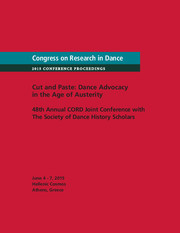No CrossRef data available.
Article contents
Coping in Collaborative Choreography: Why Coping Strategies Might Affect Learning
Published online by Cambridge University Press: 04 January 2013
Abstract
Collaborative practice in the choreographic context gives rise to behaviours that students create, modify, and abandon as they react to different situations. These behaviours are determined by a set of responses, some of which arise to cope with those of other people. The workshop presents and deconstructs a range of situations and responses, allowing participants to explore the impact of these on the collaborative process and individual learning. This is with the view of moving toward a radical proposal for assessment within the choreographic context, which prioritizes individual learning and experience over process.
- Type
- Research Article
- Information
- Copyright
- Copyright © The Author(s) 2009


